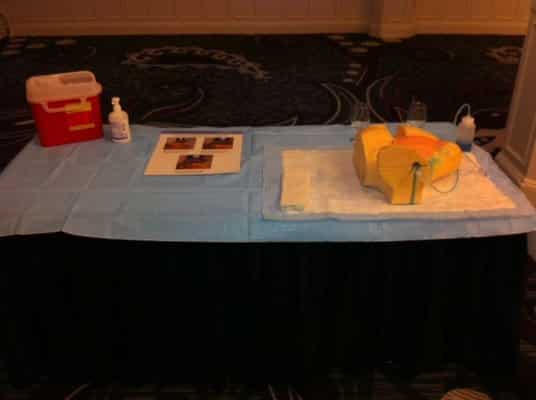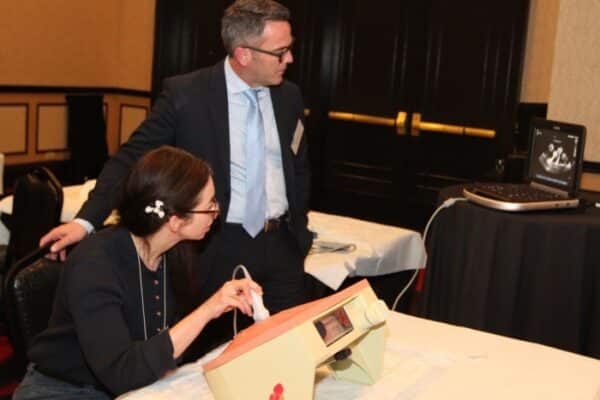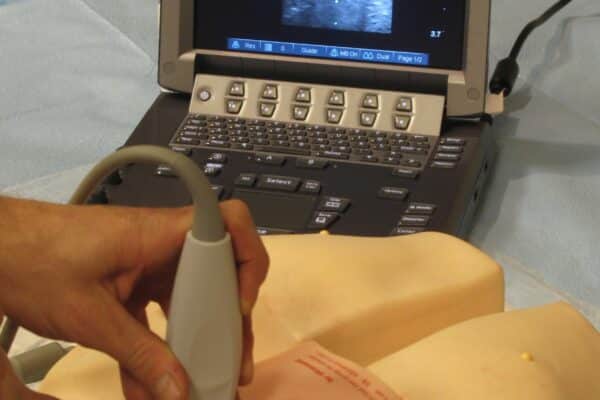Central line placement is indicated in patients who need hemodynamic monitoring, rapid volume resuscitation, therapies such as vasopressors and vesicant or central parenteral nutrition infusions and in patients with difficult venous access.

What you will Learn in the Internal Jugular Line Course
The central line placement course will teach clinicians how to place central venous catheters (subclavian line placement, internal jugular line placement and femoral line placement) using advanced simulation manikins. The course covers central venous access indications, contraindications, preparation, technique, complications and their management. Techniques for triple lumen, cordis and hemodialysis catheters will be taught. The course will cover both landmark-based central line placement and ultrasound-guided central line insertion. The course emphasizes ultrasound-guided vascular access.
The HPC Hospitalist and Emergency Procedures course will teach you how to perform central line placement in addition to endotracheal intubation, stylet-guided intubations, laryngeal mask airway (LMA) placement, King tube placement, or fiberoptic intubations. ultrasound-guided peripheral IV access, arterial lines, POCUS exams (RUSH exams and E-FAST exams), thoracentesis, paracentesis, lumbar punctures, chest tube placement, pigtail catheter placement, needle thoracostomy, procedural sedation, and ventilator management.
Why you should choose us for your internal jugular line course
Our central line placement training is a component of our live Hospitalist and Emergency Procedures CME course which teaches clinicians how to perform the 20 most essential procedures needed to work in the ER, ICU, and hospital wards.
Take your skills to the next level with our comprehensive Internal Jugular Line Course!
Internal Jugular Line Placement Photos
More information about Internal Jugular Line Placement
An internal jugular line placement may need to be performed for a variety of medical conditions, or emergency procedures. This can be a technically challenging procedure and in some cases the patient may be very ill or significantly injured.
Due to the jugular vein’s position adjacent to the carotid artery and several adjacent muscles, the internal jugular line placement must be performed with careful precision. Complications arising from the procedure can result in carotid artery damage, haematoma, and pneumothorax in some rare cases, death. As a result of the potential for serious damage to surrounding arteries and muscles, ultrasound is often used to assist in the placement of the internal jugular line.
In general, ultrasound guidance is preferred over the landmark-based technique. Ultrasound guidance has increased internal jugular line placement success rates to over 90%. Compilications arising from the procedure decreased by 57% when using ultrasound to locate the jugular vein as opposed to the landmark-based technique. The most obvious reasons for the preference for ultrasound assisted IJ line placement included a higher success rate overall, higher first attempt success, shorter access time, lower chance of carotid artery puncture, and lower chance of hematoma.
Using the ultrasound based technique, imaging provides the hospitalist or emergency physician with the location of the jugular vein. The landmark-based technique involves a physician or other qualified personnel determining the location of the jugular and best entry position according to its position relative to adjacent muscles, tissue, and arteries.
Internal placement has several proven benefits when compared to the peripheral IV placement. The internal jugular approach is preferred when possible due to the vein’s significant rate of blood flow, substantial size, relatively straight orientation, and small mal position rate. The most obvious drawback to the internal jugular vein is its location near the carotid artery. The internal jugular vein is the most typical choice for central access by anesthesiologists.
Internal jugular line placement has numerous applications for a variety of medical procedures. If you have a question that isn’t answered on this page, or if you’re just interested in discussing the procedure in greater detail, then we encourage you to contact an HPC physician directly at www.Facebook.com/HospitalProcedures. It is our goal to provide an expert online resource for your hospital procedures and emergency medicine queries. We look forward to discussing!
Internal Jugular Line Placement Course Trains Students in:
- Indications for a internal jugular venous catheter placement
- Contraindications for internal jugular venous catheter placement
- Complications of a internal jugular venous catheter placement
- Equipment for internal jugular venous catheter placement
- Proper positioning and technique for internal jugular venous catheter placement
- Coding for internal jugular venous catheter placement
Internal Jugular Line Placement Blogs
How Hospitals Can Tap into the Power of Emergency Medicine PAs
Ultrasound-Guided Paracentesis
Peripheral Administration of Vasopressors and Their Safety
Central Line or PICC Line Placement in Patients With CKD
Central Line Insertion and Associated Challenges
Hospitalist and Emergency Procedures CME Courses Available
Register HERE 21 days before the course to SAVE $50-150 and get the following:
- 12 month online access to Online CME course, procedure video bundle, instructional posters
- Indefinite online access to PDFs of all course lectures, course handouts, and HPC Adult Critical Care and Emergency Drug Reference Drug
2024-08b Hospitalist and Emergency Procedures Course – San Antonio, TX (Sunday ONLY)
Courtyard Marriott San Antonio Riverwalk Hotel
November 17, 2024
Live Course & Online Course
(Sunday ONLY)
Compare Registration Types
2024-08a Hospitalist and Emergency Procedures Course – San Antonio, TX (Saturday ONLY)
Courtyard Marriott San Antonio Riverwalk Hotel
November 16, 2024
Live Course & Online Course
(Saturday ONLY)
Compare Registration Types
2024-08 Hospitalist and Emergency Procedures Course – San Antonio, TX (WEEKEND)
Courtyard Marriott San Antonio Riverwalk Hotel
November 16-17, 2024
Live Course & Online Course
(Saturday & Sunday)
Compare Registration Types
2024-07b Hospitalist and Emergency Procedures Course – New Orleans, LA (Sunday ONLY)
Intercontinental New Orleans Hotel
October 20, 2024
Live Course & Online Course
(Sunday ONLY)
Compare Registration Types
2024-07a Hospitalist and Emergency Procedures Course – New Orleans, LA (Saturday ONLY)
Intercontinental New Orleans Hotel
October 19, 2024
Live Course & Online Course
(Saturday ONLY)
Compare Registration Types
2024-07 Hospitalist and Emergency Procedures Course – New Orleans, LA (WEEKEND)
Intercontinental New Orleans Hotel
October 19-20, 2024
Live Course & Online Course
(Saturday & Sunday)
Compare Registration Types











